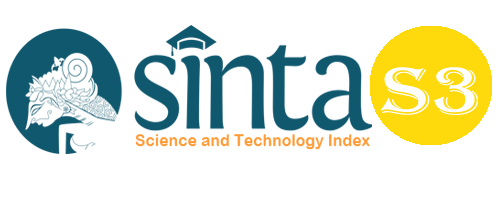Performance Improvement Strategy with Dynamic Capabilities in Service and Knowledge Management Aspects in PDAM Jember Regency
Abstract
The purpose of this study is to analyze the influence of resources on dynamic capabilities consisting of service and knowledge management aspects, as well as their effect on company performance at PDAM Kabupaten Jember. Resources are measured by indicators of production efficiency and distribution efficiency, service aspects are measured by indicators of technical services and consumer growth (customers), knowledge management is measured by indicators of the ratio of employees to consumers (customers), the ratio of education and training (training) employees, the ratio of training and education costs, company performance is measured by indicators of ROE, ROA, R and billing effectiveness. Research with SEM-PLS, research period 2011-2019, which is the period after all PDAMs in Indonesia carry out debt restructuring. The results of the study show that resources have a significant influence on aspects of service, knowledge management and company performance. Dynamic capabilities which consist of aspects of service and knowledge management have a significant influence on the company's performance of PDAM Kabupaten Jember. The results also show that dynamic capabilities are important for PDAM Kabupaten Jember to adapt to changes after debt restructuring.
Keywords
Full Text:
PDFReferences
Al-jazzazi, A., & Sultan, P. (2017). Demographic differences in Jordanian bank service quality perceptions. Journal of Bank Marketing, 35(2), 1–5.
Angelova, B., & Zekiri, J. (2011). Measuring Customer Satisfaction with Service Quality Using American Customer Satisfaction Model (ACSI Model). International Journal of Academic Research in Business and Social Sciences, 1(3), 27. https://doi.org/10.6007/ijarbss.v1i2.35
Arif, S. (2019). Influence of Leadership, Organizational Culture, Work Motivation, and Job Satisfaction of Performance Principles of Senior High School in Medan City. Budapest International Research and Critics Institute-Journal (BIRCI-Journal). P. 239-254
Barney, J. B., & Clark, D. N. (2008). Book Review : Resource-Based Theory: Creating and Sustaining Competitive Advantage. Journal of Public Affairs, 8, 309–313. https://doi.org/10.1002/pa
Birasnav, M. (2014). Knowledge management and organizational performance in the service industry: The role of transformational leadership beyond the effects of transactional leadership. Journal of Business Research, 67(8), 1622–1629. https://doi.org/10.1016/j.jbusres.2013.09.006
Carneiro, A. (2000). How does knowledge management influence innovation and competitiveness? Journal of Knowledge Management, 4(2), 87–98. https://doi.org/10.1108/13673270010372242
Charbel, S., Elie, B., & Georges, S. (2013). Impact of family involvement in ownership management and direction on financial performance of the Lebanese firms. International Strategic Management Review, 1(1–2), 30–41. https://doi.org/10.1016/j.ism.2013.08.003
Chen, J. S., & Tsou, H. T. (2007). Information Technology Adoption for Service Innovation Practices and Competitive Advantage. Proceedings - ICSSSM’06: 2006 International Conference on Service Systems and Service Management, 12(3), 472–477. https://eric.ed.gov/?id=EJ1104803
Choi, B., & Lee, H. (2003). An empirical investigation of KM styles and their effect on corporate performance. Information and Management, 40(5), 403–417. https://doi.org/10.1016/S0378-7206(02)00060-5
Chumaidiyah, E. (2014). The Marketing Mix Strategy in Influence to the Competitive Advantage. Proceedings of the 2014 International Conference on Industrial Engineering and Operations Management, 818–826.
Cohen, J. F., & Olsen, K. (2015). Knowledge management capabilities and firm performance: A test of universalistic, contingency and complementarity perspectives. Expert Systems with Applications, 42(3), 1178–1188. https://doi.org/10.1016/j.eswa.2014.09.002
Denford, J. S. (2013). Building knowledge: Developing a knowledge-based dynamic capabilities typology. Journal of Knowledge Management, 17(2), 175–194. https://doi.org/10.1108/13673271311315150
Dogan, B., Özdemirci, A., & Güngör, N. (2014). A Research on Competitive Strategies, Environmental Factors and Human Resources Architecture Relations. International Business Research, 7(3). https://doi.org/10.5539/ibr.v7n3p115
Donate, M. J., & Sánchez de Pablo, J. D. (2015). The role of knowledge-oriented leadership in knowledge management practices and innovation. Journal of Business Research, 68(2), 360–370. https://doi.org/10.1016/j.jbusres.2014.06.022
Fadah, I., Hasanah, N., Endhiarto, T., & Juniar, A. (2020). Determinants of the Dividend Payout Policy of Public Companies in Indonesia, Based on Financial Ratio Analysis. International Journal of Innovation, Creativity and Change, 13(4), 1084–1098. www.ijicc.net
Ghorbanizadeh, V., Roodsaz, H., Sharifzadeh, F., & Sadeghi, M. (2019). The Effect of Individual Knowledge Management on Organizational Performance of Tehran Municipality. Urban Economics and Management, 7(2(26)), 49–63.
Gupta, S., Malhotra, N. K., Czinkota, M., & Foroudi, P. (2016). Marketing innovation: A consequence of competitiveness. Journal of Business Research, 69(12), 5671–5681. https://doi.org/10.1016/j.jbusres.2016.02.042
Han, Y., & & Li, D. (2015). Effects Of Intellectual Capital on Innovative Performance: The Role of Knowledge‐Based Dynamic Capability. Management Decision, 53(1), 40–56.
Harlow, H. (2008). The effect of tacit knowledge on firm performance. Journal of Knowledge Management, 12(1), 148–163. https://doi.org/10.1108/13673270810852458
Helfat, C. E. (1997). Know-how and asset complementarity and dynamic capability accumulation: The case of R&D. Strategic Management Journal, 18(5), 339–360. https://doi.org/10.1002/(SICI)1097-0266(199705)18:5<339::AID-SMJ883>3.0.CO;2-7
Henao-García, E. A., Lozada, N., & Arias-Pérez, J. (2020). Direct effects of knowledge management practices on organizational performance. Business Information Review, 37(1), 30–37. https://doi.org/10.1177/0266382120909073
Ibrahim, F., Edgar, D., & Reid, V. (2009). Assessing the role of knowledge management in adding value: Moving towards a comprehensive framework. Journal of Information and Knowledge Management, 8(4), 275–286. https://doi.org/10.1142/S0219649209002397
Joshi, A., Prichard, W., & Heady, C. (2014). Taxing the Informal Economy: The Current State of Knowledge and Agendas for Future Research. Journal of Development Studies, 50(10), 1325–1347. https://doi.org/10.1080/00220388.2014.940910
Juniar, A., Fadah, I., & Rahmawati, R. (2018). Strategy of financial efficiency of coal companies in Indonesia in the era of disruption. International Journal of Scientific and Technology Research, 7(11), 89–93. http://www.scopus.com/inward/record.url?eid=2-s2.0-85059858693&partnerID=MN8TOARS
Kalling, T. (2003). Knowledge management and the occasional links with performance. Journal of Knowledge Management, 7(3), 67–81. https://doi.org/10.1108/13673270310485631
Kaltenbrunner, K., & Renzl, B. (2014). Dynamic capabilities at the civil protection exercise: EU Taranis 2013. Research in Competence-Based Management, 7, 247–267. https://doi.org/10.1108/S1744-211720140000007009
Kamukama, N., Ahiauzu, A., & Ntayi, J. M. (2011). Competitive advantage: Mediator of intellectual capital and performance. Journal of Intellectual Capital, 12(1), 152–164. https://doi.org/10.1108/14691931111097953
Kaplan, R. S., & Norton, D. P. (2000). Having Trouble With Your Strategy? Then Map It. Harvar Business Review.
Kaplan, R., & Norton, D. (2012). Alignment: Using The Balanced Scorecard to Create Synergies. Harvard Business School press.
Kusuma, H. (2006). Dampak Manajemen Laba Terhadap Relevansi Informasi Akuntansi: Bukti Empiris Dari Indonesia. Jurnal Akuntansi Dan Keuangan, 8(1), 1–12. https://doi.org/10.9744/jak.8.1.pp.1-12
Lee, K. C., Lee, S., & Kang, I. W. (2005). KMPI: Measuring knowledge management performance. Information and Management, 42(3), 469–482. https://doi.org/10.1016/j.im.2004.02.003
Lestari, S. D., Muhdaliha, E., & Putra, A. H. P. K. (2020). E-commerce performance based on knowledge management and organizational innovativeness. Journal of Distribution Science, 18(2), 49–58. https://doi.org/10.15722/jds.18.2.20202.49
Lin, C., & Tseng, S. M. (2005). The implementation gaps for the knowledge management system. Industrial Management and Data Systems, 105(2), 208–222. https://doi.org/10.1108/02635570510583334
Massingham, P. (2004). Linking business level strategy with activities and knowledge resources. Journal of Knowledge Management, 8(6), 50–62. https://doi.org/10.1108/13673270410567620
Niati, D. R., Siregar, Z. M. E., & Prayoga, Y. (2021). The Effect of Training on Work Performance and Career Development: The Role of Motivation as Intervening Variable. Budapest International Research and Critics Institute (BIRCI-Journal): Humanities and Social Sciences, 4(2), 2385–2393. https://doi.org/10.33258/birci.v4i2.1940
Nuhu, N. A., Baird, K., & Appuhami, R. (2019). The impact of management control systems on organisational change and performance in the public sector: The role of organisational dynamic capabilities. Journal of Accounting and Organizational Change, 15(3), 473–495. https://doi.org/10.1108/JAOC-08-2018-0084
Nunes, M. B., Annansingh, F., Eaglestone, B., & Wakefield, R. (2006). Knowledge management issues in knowledge-intensive SMEs. Journal of Documentation, 62(1), 101–119. https://doi.org/10.1108/00220410610642075
Nwannyanwu, L. A. (2017). Audit Quality Practices and Financial Reporting in Nigeria. International Journal of Academic Research in Accounting, Finance and Management Sciences, 7(2), 145–155. https://doi.org/10.6007/ijarafms/v7-i2/2879
Ocak, M., & Findik, D. (2019). The impact of intangible assets and sub-components of intangible assets on sustainable growth and firm value: Evidence from Turkish listed firms. Sustainability (Switzerland), 11(19), 5–7. https://doi.org/10.3390/su11195359
Omerzel, D. G., & Gulev, R. E. (2011). Knowledge Resources and Competitive Advantage. Managing Global Transitions, 9(4 (Winter)), 335–354.
Ondoro, C. O. (2015). Measuring Organization Performance from Balanced Scorecard to Balanced ESG Framework. International Journal of Economics, Commerce and Management, 3(11), 715–725. http://ijecm.co.uk/
Pakurár, M., Haddad, H., Nagy, J., Popp, J., & Oláh, J. (2019). The service quality dimensions that affect customer satisfaction in the Jordanian banking sector. Sustainability (Switzerland), 11(4), 1–24. https://doi.org/10.3390/su11041113
Pasaribu, R. D., Kartini, D., Oesman, Y. ., & Padmadisastra, S. (2016). The Effect Of Customer Demand And Supplier Performance In Competitive Strategy And Business Performance (Case Of Fixed Broadband In Indonesia). International Journal of Scientific & Technology Research, 5(02). https://doi.org/10.1201/9780429295348-178
Pitelis, C. (2009). Value Capture from Organizational Advantages and Sustainable Value Creation.
Qurtubi, Q., Trisnaningtias, D. M., & Yudhanata, M. F. (2019). Identifikasi Variabel yang Berpengaruh terhadap Kinerja Pemasaran dan Indikator Kinerja Pemasaran untuk Industri Hotel. Jurnal Sistem Dan Manajemen Industri, 3(1), 1. https://doi.org/10.30656/jsmi.v3i1.1432
Rauch, D. A., Collins, M. D., Nale, R. D., & Barr, P. B. (2015). Measuring service quality in mid-scale hotels. International Journal of Contemporary Hospitality Management, 27(1), 87–106. https://doi.org/10.1108/IJCHM-06-2013-0254
Rehman, S., Mohamed, R., & Ayoup, H. (2019). The mediating role of organizational capabilities between organizational performance and its determinants. Journal of Global Entrepreneurship Research, 9(1). https://doi.org/10.1186/s40497-019-0155-5
Saad M, A. S., & Zhengge, T. (2015). The Impact of Organizational Factors on Financial Performance: Building a Theoretical Model. International Journal of Management Science and Business Administration, 2(7), 51–57. https://doi.org/10.18775/ijmsba.1849-5664-5419.2014.27.1005
Shujahat, M., Hussain, S., Javed, S., Malik, M. I., Thursamy, R., & Ali, J. (2017). Strategic Management Model with Lens of Knowledge Management and Competitive Intelligence: A Review Approach. Journal of Information and Knowledge Management Systems, 47(1).
SiJing, L. (2002). Analysis and design of knowledge management system: a case study - analysis and design of knowledge management system in SDIC/CAAS. AFITA 2002: Asian Agricultural Information Technology & Management. Proceedings of the Third Asian Conference for Information Technology in Agriculture.
Stiles, P., & Kulvisaechana, S. (2004). Human Capital and Performance in Public Sector. Stiles, P. and Kulvisaechana, S. (2004Judge Institute of Management, University of Cambridge.
Sundiman, D. (2018). the Effect of Knowledge Management on the Strategic Management Process Mediated By Competitive Intelligence in the Small Business Company. Jurnal Manajemen Dan Kewirausahaan, 20(2), 105–115. https://doi.org/10.9744/jmk.20.2.105-115
Szymanski, D. M., & Henard, D. H. (2001). Customer satisfaction: A meta-analysis of the empirical evidence. Journal of the Academy of Marketing Science, 29(1), 16–35. https://doi.org/10.1177/009207030102900102
Tang, Y.-C., & Liou, F.-M. (2010). Does Firm Performance Reveal Its Own Causes? The Role of Beynesian Inference. Strategic Management Journal. https://doi.org/10.1002/smj
Teece, D., & Pisano, G. (1994). The Dynamic Capabilities of Firms: An Introduction. In Mutation Research - Fundamental and Molecular Mechanisms of Mutagenesis. https://doi.org/10.1016/0027-5107(94)90319-0
Tseng, S. M., & Lee, P. S. (2014). The effect of knowledge management capability and dynamic capability on organizational performance. Journal of Enterprise Information Management, 27(2), 158–179. https://doi.org/10.1108/JEIM-05-2012-0025
Widodo, W., Suendarti, M., & Hasbullah, H. (2020). Exploring The Effect of Knowledge Management and Social Intelligence on Professional Performance of Mathematics Teachers: A Mediating by Achievement Motivation. Journal of Xidian University, 14(6), 749–757. https://doi.org/10.37896/jxu14.6/085
Yang, B., Zheng, W., & Viere, C. (2009). Holistic Views of Knowledge Management Models. Advances in Developing Human Resources, 11(3), 273–289. https://doi.org/10.1177/1523422309338584
Yarimoglu, E. K. (2014). A Review on Dimensions of Service Quality Models. Journal of Marketing Management, 2(2), 79–93.
Zack, M., McKeen, J., & Singh, S. (2009). Knowledge management and organizational performance: An exploratory analysis. Journal of Knowledge Management, 13(6), 392–409. https://doi.org/10.1108/13673270910997088
Zott, C. (2003). Dynamic capabilities and the emergence of intraindustry differential firm performance: Insights from a simulation study. Strategic Management Journal, 24(2), 97–125. https://doi.org/10.1002/smj.288
DOI: https://doi.org/10.33258/birci.v5i3.6766
Article Metrics
Abstract view : 58 timesPDF - 16 times
Refbacks
- There are currently no refbacks.

This work is licensed under a Creative Commons Attribution-ShareAlike 4.0 International License.

This work is licensed under a Creative Commons Attribution-ShareAlike 4.0 International License.

_.gif)

















_.gif)



